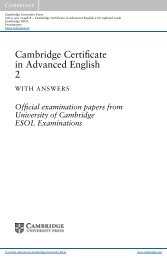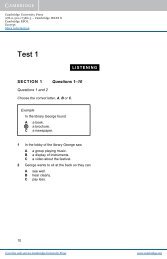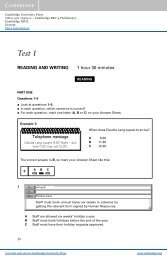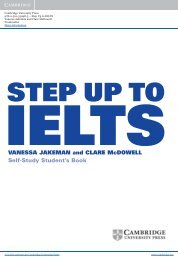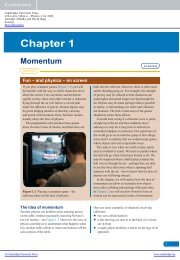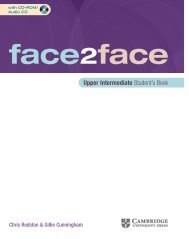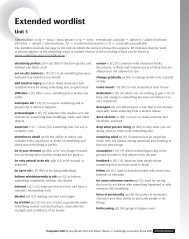Skills for Study Level 2 Teacher's Book - Cambridge University Press
Skills for Study Level 2 Teacher's Book - Cambridge University Press
Skills for Study Level 2 Teacher's Book - Cambridge University Press
You also want an ePaper? Increase the reach of your titles
YUMPU automatically turns print PDFs into web optimized ePapers that Google loves.
9 An explanation that the experiment was successful10 A brief summary of the methods used ✔11 A hypothesis that you will test in the research ✔(if ahypothesistestexperiment)12 A brief discussion of the results of the experiment13 An explanation of special equipment used in the experiment2bSuggested answersA Accurately measuring the density of waterIntroductionDensity is an intensive property: in any pure substance it remains constant ata given temperature, regardless of size. However, due to expansion caused byheating, the density of a substance will change at different temperatures.The density of an object depends on its mass and volume, where 2Density = mass/volumeIn this experiment the density of pure water was determined using a volumetricpipette and an accurate balance, and the results compared to published data<strong>for</strong> given temperatures 6/10 .B <strong>Study</strong>ing pressure changes in pipe flowIntroductionUnderstanding the flow of fluids under pressure along pipes is important in civiland chemical engineering 1 . Static pressure is the pressure of water at rest ina pipe. Water will flow along a pipe only under a pressure difference, with thepressure difference determining how fast the water flows. <strong>Press</strong>ure measuredwhile the fluid is moving is referred to as dynamic pressure 2 . This experimentinvestigated the way that pressure drops along a pipe while water flows throughit. The objective of the experiment was to determine whether pressure dropvaries with the length or diameter of the pipe, or the flow rate of the water 6 .C Improving agricultural yields through water run-off irrigationIntroductionIrrigation <strong>for</strong> agriculture is vital <strong>for</strong> food production, food security, humanhealth and rural livelihoods (de Fraiture et al., 2009). Irrigated agricultural landareas around the world more than doubled between 1960 and 2003 (FAO, 2007),accompanied by rising food production yields. As world population continuesto grow, securing food supplies becomes ever more critical. However, despite ahalf century of increasing agricultural yields, and clear evidence that irrigationis an effective means by which to increase output from farmland, researchindicates that the productivity of most agricultural land relying on rainwater isfar below possible yields, with some agricultural land in arid regions producingless than 20% of potential yields under irrigation (World Water AssessmentProgramme, 2009, p.108) 1 . This paper reports the results of an investigationof an irrigation scheme in Yemen using water run-off and low-impact drylandfarming techniques. It was found that crop yields could be improved by up to15% under irrigation compared to traditional non-irrigated farming methods aspractised in the area 6/10 .Unit 2 Part E ∙ Reporting in writing 63



